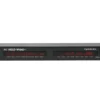The multi-room streaming amplifier relies on WiFi technology, so it’s crucial to have a deep dive into WiFi technology—its past, its present, and its future.
Although modern Wi-Fi has its roots in the 1880s, wireless local area networks were not formally established until 1971. It was during this year that ALOHAnet used Ultra High Frequency (UHF) radio waves to connect the island of Hawaii with the first version of wireless internet.
The initial Wi-Fi-connected seven computers across different Hawaiian islands. The seven computers were able to communicate with a central computer all without using phone lines. This was a huge deal at the time, as it had never been done before.

What Is the Difference Between Bluetooth and Wi-Fi?
Wi-Fi is a wireless technology that your device uses to connect you to the internet without the need for a cable. Under the IEEE WiFi standards, the different frequency bands that Wi-Fi uses are split into separate channels that overlap in frequency. This is why Wi-Fi uses channels that are far apart.
Bluetooth, on the other hand, is a technology whose purpose is to transfer data over short distances between devices. Bluetooth uses radio signals just like Wi-Fi.
Bluetooth often uses the same frequency band as your Wi-Fi connection. This can cause interference problems within your home Wi-Fi network at times.
Other differences include:
- Bluetoothrequires a wireless adapter to connect to devices. Whereas Wi-Fi requires a wireless adaptor and wireless router to be able to connect.
- Bluetoothconsumes a lower amount of power. Wi-Fi consumes high power.
- Because Bluetoothdoesn’t require a password to connect, it’s less secure than Wi-Fi. On the other hand, Wi-Fi is a much more secure network to use on your device.
- Bluetoothhas a radio signal range of ten meters. Whereas Wi-Fi has a radio signal range of one hundred meters.
- Bluetoothrequires low bandwidth. Whereas Wi-Fi requires higher available bandwidth.
WiFi Generations Comparison Table
| WiFi Version | Year | Frequency | Max Speed | Notable Features |
|---|---|---|---|---|
| WiFi 1 (802.11) | 1997 | 2.4 GHz | 2 Mbps | First WiFi standard, very slow |
| WiFi 2 (802.11b) | 1999 | 2.4 GHz | 11 Mbps | Affordable but interference-prone |
| WiFi 3 (802.11g) | 2003 | 2.4 GHz | 54 Mbps | Improved speed, still affected by interference |
| WiFi 4 (802.11n) | 2009 | 2.4 & 5 GHz | 600 Mbps | Introduced MIMO, dual-band support |
| WiFi 5 (802.11ac) | 2014 | 5 GHz | 1.3 Gbps | Beamforming, better signal quality |
| WiFi 6 (802.11ax) | 2019 | 2.4 & 5 GHz | 9.6 Gbps | Higher efficiency, lower latency |
| WiFi 6E (Extended) | 2020 | 6 GHz | 9.6 Gbps | More channels, less interference |
| WiFi 7 (802.11be) | 2024 | 2.4, 5, & 6 GHz | 46 Gbps | Faster speeds, lower latency, ideal for AR/VR |

- Launch Year:1997
- Frequency:4 GHz
- Speed:2 Mbps
- Key Features:First-ever wireless LAN protocol; very slow compared to modern standards.
- Launch Year:1999
- Frequency:4 GHz
- Speed:Up to 11 Mbps
- Key Features:Wider adoption due to affordability; interference issues with household devices like microwaves and cordless phones.
- Launch Year:2003
- Frequency:4 GHz
- Speed:Up to 54 Mbps
- Key Features:Backward compatibility with 802.11b; improved speed but still affected by interference.
- Launch Year:2009
- Frequency:4 GHz & 5 GHz
- Speed:Up to 600 Mbps
- Key Features:First dual-band WiFi; introduced MIMO (Multiple Input Multiple Output) for better data transmission.
- Launch Year:2014
- Frequency:5 GHz
- Speed:Up to 1.3 Gbps
- Key Features:Improved beamforming, reduced congestion, and better signal quality.
- Launch Year:2019
- Frequency:4 GHz & 5 GHz
- Speed:Up to 9.6 Gbps
- Key Features:Higher efficiency, lower latency, better performance in crowded areas, and improved battery life.
WiFi 6E (2020) – Extended WiFi 6
- Launch Year:2020
- Frequency:6 GHz
- Speed:Up to 9.6 Gbps
- Key Features:Less interference, more available channels, and higher speeds.
- Launch Year:2024
- Frequency:4 GHz, 5 GHz & 6 GHz
- Speed:Expected up to 46 Gbps
- Key Features:Enhanced multi-link operations, reduced latency, and massive data throughput for AR/VR applications.







